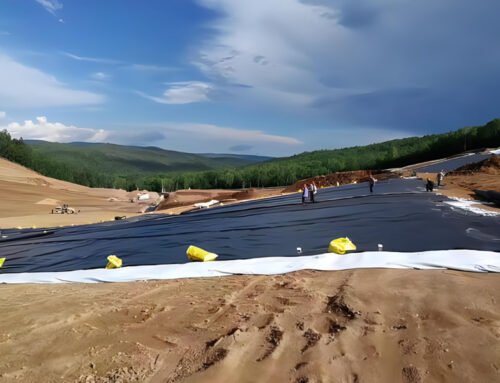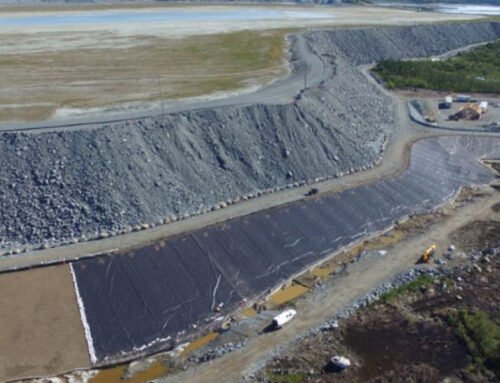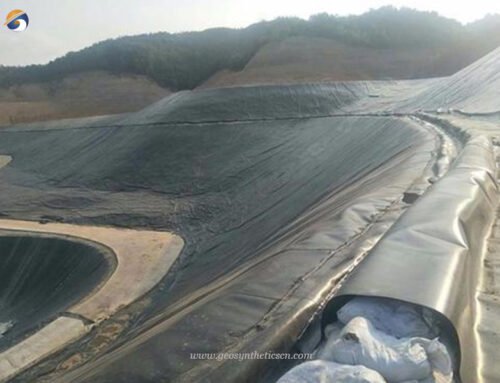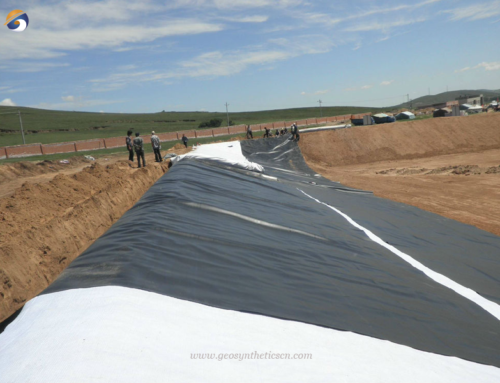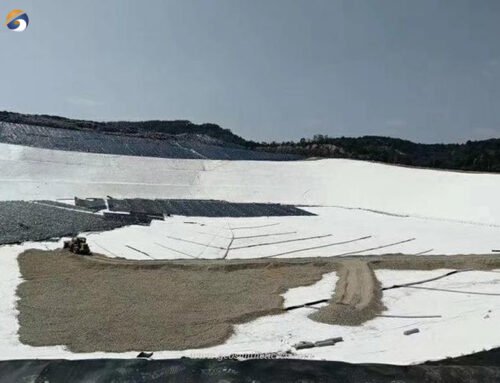What is HDPE Pond Membrane?
HDPE pond membrane, also known as HDPE geomembrane liner, is made of high polyethylene raw materials, adding 2%-3% of carbon black, anti-oxidation, anti-aging and anti-ultraviolet components, and is made by first-class automatic production equipment and three-layer pressing process. HDPE pond membrane is an excellent product for larger applications requiring UV and ozone resistance, chemical resistance or high-quality installation. HDPE geomembranes are a cost-effective option for exposed lining projects and are widely used in aquaculture, solid waste containment, mining, water containment applications and biogas digester projects.
HDPE geomembrane lliner are used to create a reliable barrier that prevents water seepage and leakage, ensuring the containment and preservation of water within the pond or reservoir. They are typically manufactured in large rolls and are available in different thicknesses, ranging from 0.5 to 3 millimeters or more, depending on the specific requirements of the project.
HDPE pond membrane is important for the overall water containment, protection and health of your shrimp or fish farm ponds. HDPE pond membrane is the preferred lining material for shrimp or fish farm projects, that is, as the real foundation of your shrimp or fish farm, HDPE geomembrane liner is the best Pond lining.
Case Study Shrimp Pond Membrane Liner in Sri Lanka
- Location – Sri Lanka
- Products – HDPE Pond Membrane
- Application – Shrimp Pond in Sri Lanka


What is The Problems of Shrimp Pond Project in Sri Lanka
Our Bangladeshi customer left a message on social media Facebook telling us that he needed to purchase geomembrane pond liner for shrimp ponds and asked about the price of the geomembrane. In Bangladesh, shrimp farming is usually carried out in coastal areas because of the availability of brackish or seawater supply ponds. Also, the land is swampy or sandy, and sometimes organic soils may appear. Such land is not suitable for growing crops or plantations, and the price is relatively cheap. Such land is also used to build ponds, and ponds built in soils that contain pyrite (potentially acid sulfate or active acid sulfate soils) can create low pH levels, which can cause problems for shrimp farming. Ponds built in sandy soil do not hold water well. Organic soils do not allow stable dikes and have a high oxygen demand. Due to the low-lying terrain, shrimp ponds built in these areas face difficulties in drainage and drying after harvest. The bottom of the pond is not completely dry, and after a few prawns have been raised, the bottom of the pond can deteriorate, which can stress the prawns and facilitate disease outbreaks.
How to Build Shrimp Pond Project in Sri Lanka
The customer shrimp farming in Bangladesh encountered the above problem. After communicating with our company, we recommended the customer to use a 0.5mm geomembrane pond liner. This method separates the pond water from the soil. Due to its durable and unbreakable characteristics, the pads not only effectively prevent weeds, sludge and other obstructive pollutants from entering the pond, but also reduce the bacteria in the pond environment, thereby reducing the use of antibiotics. In addition, HDPE pond membrane also protect pond slopes from erosion and are extremely convenient for servicing and quick removal of sediment and waste. We provided customers with 0.5mm HDPE pond membrane samples for testing. After receiving the samples for testing, the customer was very satisfied with the results. The customer purchased a 0.5mm HDPE pond membrane for use in a shrimp farming plant. Our team also provides customers with professional advice and guidance on the installation of HDPE pond membrane. During the installation process, we wholeheartedly considered the customer, gave the customer a detailed description of the specific steps of the installation, and reminded the customer to pay attention to three points:
(1) Before laying, the laying surface should be leveled and compacted, and sandbags or heavy objects should be prepared to prevent the laid HDPE pond membrane from being blown away by the wind.
(2) The slope of the breeding pond should not exceed 45°C, otherwise it is easy to collapse and it is not convenient for breeding.
(3) The anchoring ditch shall be dug into a U-shaped ditch or inverted trapezoidal ditch of 40cm-50cm, and then backfilled with soil.

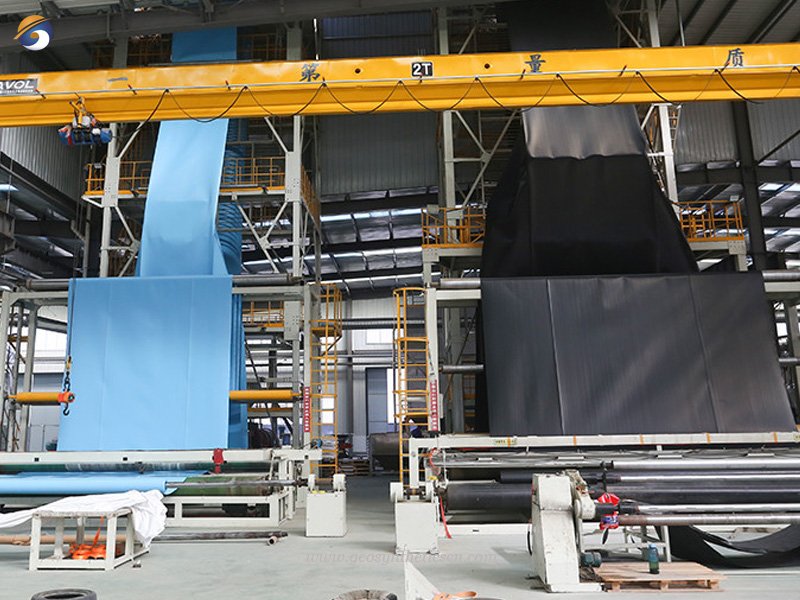
Benefits of HDPE Pond Membrane for Shrimp Pond Project in Sri Lanka
1. HDPE pond membrane in aquaculture are all made of high-quality new geomembrane special resins as raw materials. The production procedures are strictly controlled. Each roll of the manufactured products has been professionally tested, and all indicators have reached and exceeded international standards. Environmentally friendly and non-toxic. The aquaculture film has the characteristics of tensile resistance, impact resistance, high tear resistance, and high resistance to hydrostatic pressure, and has the characteristics of acid and alkali corrosion resistance, anti-microbial erosion and good anti-seepage performance. The bottom of the pond or the pond can be completely separated from the pond water, which has a significant effect on anti-leakage, virus pollution, and anti-microbial erosion in the high and low shrimp ponds. Because the aquaculture membrane is smooth, it is not only convenient for disinfection and dredging, but also helps prevent the spread of pathogens at the bottom, shortens the time for cleaning the bottom of shrimp ponds and drying ponds, and can be stocked seven days after the drainage ditch, which can increase the number of shrimp farming and reduce shrimp farming. cost.
2. The black color of pond membrane is opaque, which inhibits the growth of the grass at the bottom of the pool. There is no need to worry about the grass arching upwards and destroying the film. The black film can keep warm, increase the temperature of the water body, keep the water warm, and shorten the breeding cycle.
3. The HDPE pond membrane has the dual functions of waterproofing and preventing the penetration of plant roots, which can withstand the puncture of plant roots and maintain the waterproof function for a long time. It can form a high-strength waterproof layer, which has strong resistance to pressurized water, and is resistant to puncture, tear and fatigue. Geomembrane is a flexible waterproof material with high impermeability coefficient and good heat resistance and cold resistance. Geomembrane has good chemical stability, can resist strong acid and alkali, and its high tensile strength can meet the needs of shrimp pond projects.
GEOSINCERE has been dedicated to manufacturing geomembrane and geosynthetics products and solutions to worldwide customers since its foundation in 2007. Any problems and inquiries, please contact us.

